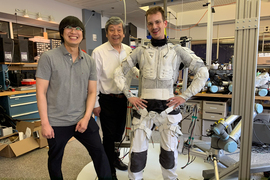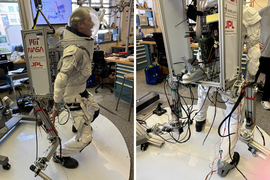Need a moment of levity? Try watching videos of astronauts falling on the moon. NASA’s outtakes of Apollo astronauts tripping and stumbling as they bounce in slow motion are delightfully relatable.
For MIT engineers, the lunar bloopers also highlight an opportunity to innovate.
“Astronauts are physically very capable, but they can struggle on the moon, where gravity is one-sixth that of Earth’s but their inertia is still the same. Furthermore, wearing a spacesuit is a significant burden and can constrict their movements,” says Harry Asada, professor of mechanical engineering at MIT. “We want to provide a safe way for astronauts to get back on their feet if they fall.”
Asada and his colleagues are designing a pair of wearable robotic limbs that can physically support an astronaut and lift them back on their feet after a fall. The system, which the researchers have dubbed Supernumerary Robotic Limbs or “SuperLimbs” is designed to extend from a backpack, which would also carry the astronaut’s life support system, along with the controller and motors to power the limbs.
The researchers have built a physical prototype, as well as a control system to direct the limbs, based on feedback from the astronaut using it. The team tested a preliminary version on healthy subjects who also volunteered to wear a constrictive garment similar to an astronaut’s spacesuit. When the volunteers attempted to get up from a sitting or lying position, they did so with less effort when assisted by SuperLimbs, compared to when they had to recover on their own.
The MIT team envisions that SuperLimbs can physically assist astronauts after a fall and, in the process, help them conserve their energy for other essential tasks. The design could prove especially useful in the coming years, with the launch of NASA’s Artemis mission, which plans to send astronauts back to the moon for the first time in over 50 years. Unlike the largely exploratory mission of Apollo, Artemis astronauts will endeavor to build the first permanent moon base — a physically demanding task that will require multiple extended extravehicular activities (EVAs).
“During the Apollo era, when astronauts would fall, 80 percent of the time it was when they were doing excavation or some sort of job with a tool,” says team member and MIT doctoral student Erik Ballesteros. “The Artemis missions will really focus on construction and excavation, so the risk of falling is much higher. We think that SuperLimbs can help them recover so they can be more productive, and extend their EVAs.”
Asada, Ballesteros, and their colleagues will present their design and study this week at the IEEE International Conference on Robotics and Automation (ICRA). Their co-authors include MIT postdoc Sang-Yoep Lee and Kalind Carpenter of the Jet Propulsion Laboratory.
Taking a stand
The team’s design is the latest application of SuperLimbs, which Asada first developed about a decade ago and has since adapted for a range of applications, including assisting workers in aircraft manufacturing, construction, and ship building.
Most recently, Asada and Ballesteros wondered whether SuperLimbs might assist astronauts, particularly as NASA plans to send astronauts back to the surface of the moon.
“In communications with NASA, we learned that this issue of falling on the moon is a serious risk,” Asada says. “We realized that we could make some modifications to our design to help astronauts recover from falls and carry on with their work.”
The team first took a step back, to study the ways in which humans naturally recover from a fall. In their new study, they asked several healthy volunteers to attempt to stand upright after lying on their side, front, and back.
The researchers then looked at how the volunteers’ attempts to stand changed when their movements were constricted, similar to the way astronauts’ movements are limited by the bulk of their spacesuits. The team built a suit to mimic the stiffness of traditional spacesuits, and had volunteers don the suit before again attempting to stand up from various fallen positions. The volunteers’ sequence of movements was similar, though required much more effort compared to their unencumbered attempts.
The team mapped the movements of each volunteer as they stood up, and found that they each carried out a common sequence of motions, moving from one pose, or “waypoint,” to the next, in a predictable order.
“Those ergonomic experiments helped us to model in a straightforward way, how a human stands up,” Ballesteros says. “We could postulate that about 80 percent of humans stand up in a similar way. Then we designed a controller around that trajectory.”
Helping hand
The team developed software to generate a trajectory for a robot, following a sequence that would help support a human and lift them back on their feet. They applied the controller to a heavy, fixed robotic arm, which they attached to a large backpack. The researchers then attached the backpack to the bulky suit and helped volunteers back into the suit. They asked the volunteers to again lie on their back, front, or side, and then had them attempt to stand as the robot sensed the person’s movements and adapted to help them to their feet.
Overall, the volunteers were able to stand stably with much less effort when assisted by the robot, compared to when they tried to stand alone while wearing the bulky suit.
“It feels kind of like an extra force moving with you,” says Ballesteros, who also tried out the suit and arm assist. “Imagine wearing a backpack and someone grabs the top and sort of pulls you up. Over time, it becomes sort of natural.”
The experiments confirmed that the control system can successfully direct a robot to help a person stand back up after a fall. The researchers plan to pair the control system with their latest version of SuperLimbs, which comprises two multijointed robotic arms that can extend out from a backpack. The backpack would also contain the robot’s battery and motors, along with an astronaut’s ventilation system.
“We designed these robotic arms based on an AI search and design optimization, to look for designs of classic robot manipulators with certain engineering constraints,” Ballesteros says. “We filtered through many designs and looked for the design that consumes the least amount of energy to lift a person up. This version of SuperLimbs is the product of that process.”
Over the summer, Ballesteros will build out the full SuperLimbs system at NASA’s Jet Propulsion Laboratory, where he plans to streamline the design and minimize the weight of its parts and motors using advanced, lightweight materials. Then, he hopes to pair the limbs with astronaut suits, and test them in low-gravity simulators, with the goal of someday assisting astronauts on future missions to the moon and Mars.
“Wearing a spacesuit can be a physical burden,” Asada notes. “Robotic systems can help ease that burden, and help astronauts be more productive during their missions.”
This research was supported, in part, by NASA.















